Analysis of the Economic Impact of Automotive Industry Closure
VerifiedAdded on 2020/04/07
|19
|4575
|45
Report
AI Summary
This report provides a comprehensive analysis of the closure of the automotive industry in Australia, examining the decisions of Ford, Holden, and Toyota to withdraw from the market. It explores the economic impacts of this closure, including job losses in the automotive supply chain and component industries, and the potential for adapting to changes. The report delves into the historical context of the Australian automotive industry, research objectives, and key research questions. It reviews the literature on the global automotive manufacturing industry, highlighting the role of the automotive industry in the Australian economy, domestic market share losses, and the reasons behind the withdrawal of major car manufacturing companies. The report also discusses the impact on workers, the causes of the withdrawal, and potential governmental policies to save the automotive industry. The report concludes with an assessment of the industry's future and recommendations for managing the risks associated with the closure decision.
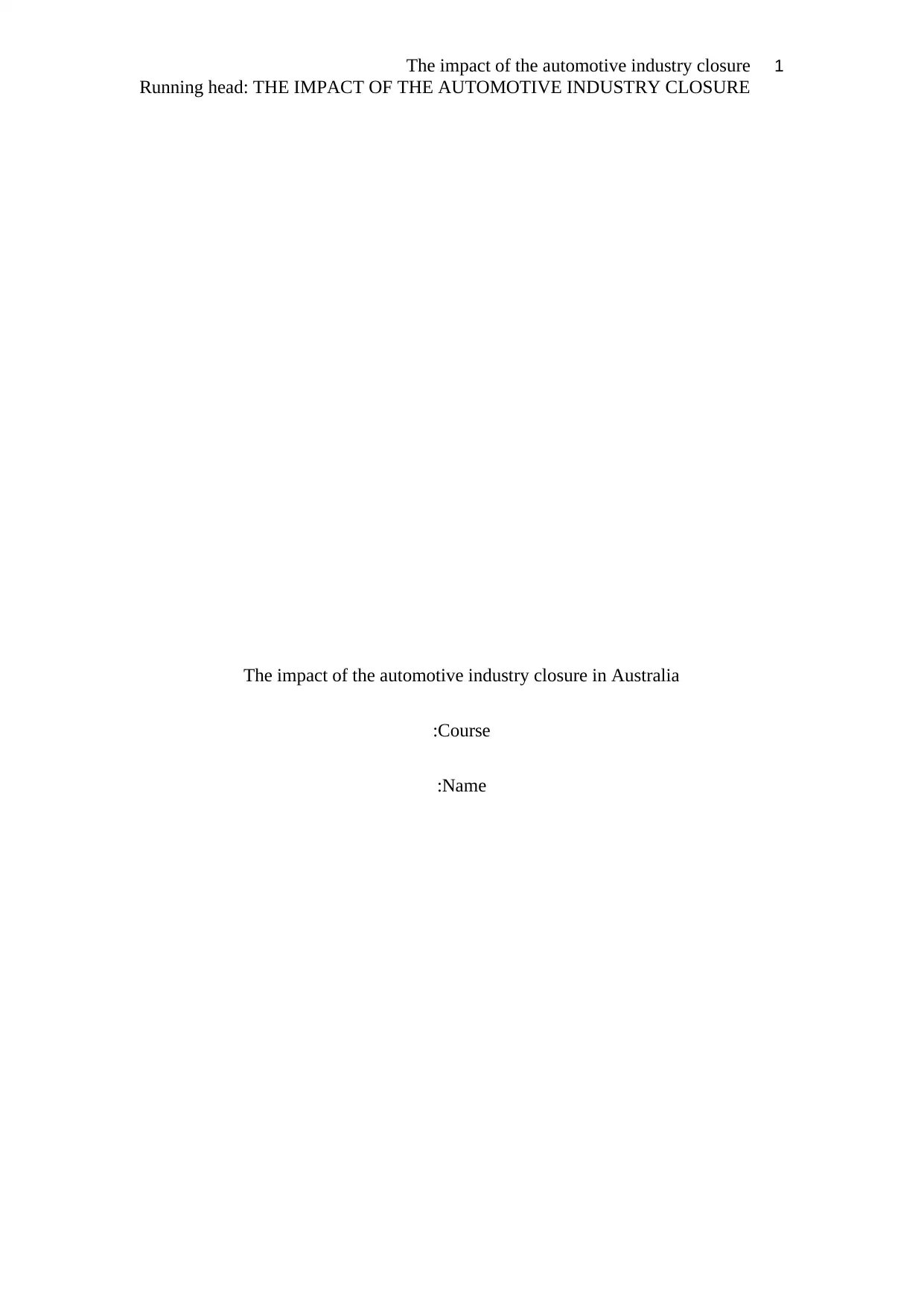
1The impact of the automotive industry closure
Running head: THE IMPACT OF THE AUTOMOTIVE INDUSTRY CLOSURE
The impact of the automotive industry closure in Australia
Course:
Name:
Running head: THE IMPACT OF THE AUTOMOTIVE INDUSTRY CLOSURE
The impact of the automotive industry closure in Australia
Course:
Name:
Paraphrase This Document
Need a fresh take? Get an instant paraphrase of this document with our AI Paraphraser
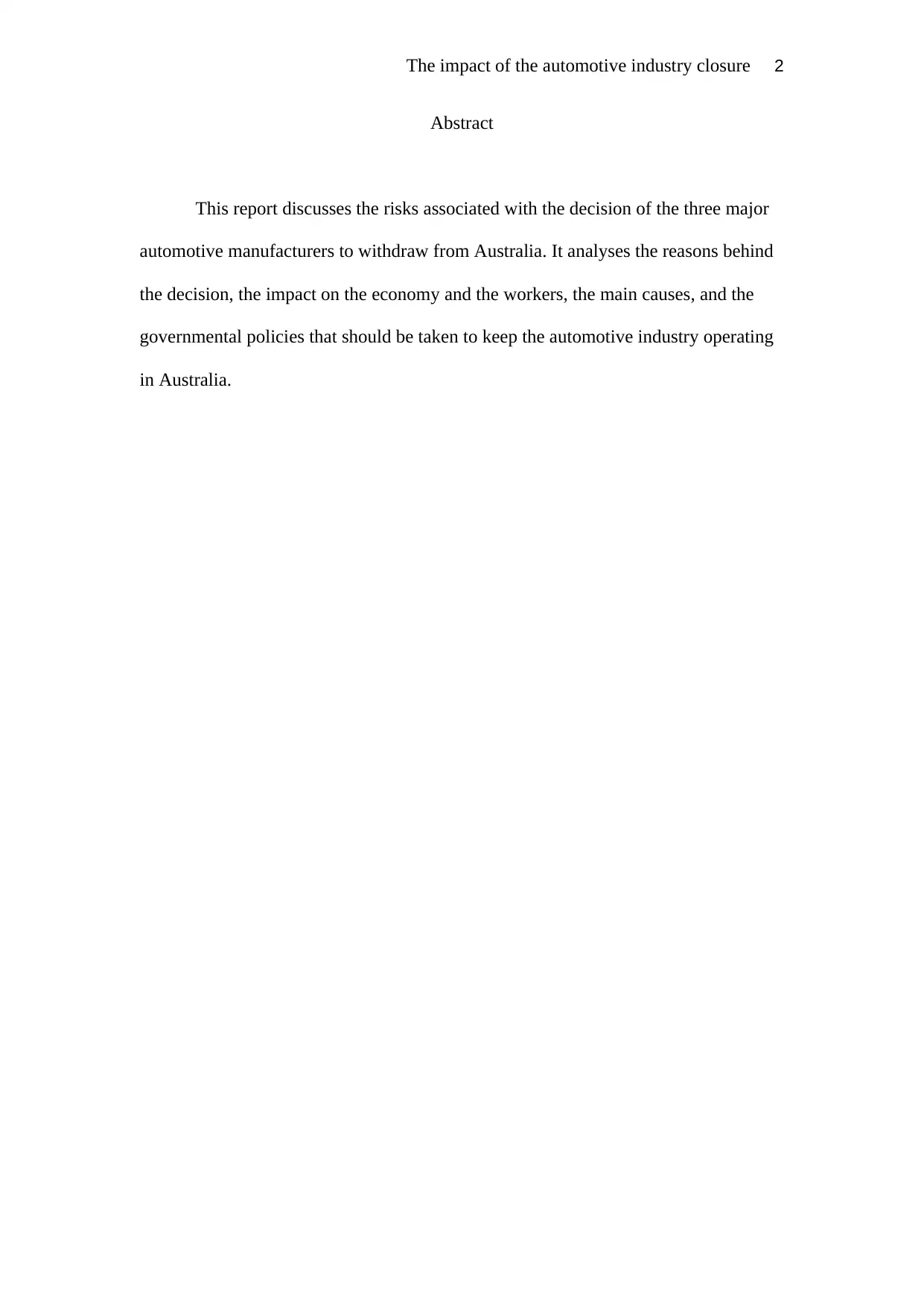
2The impact of the automotive industry closure
Abstract
This report discusses the risks associated with the decision of the three major
automotive manufacturers to withdraw from Australia. It analyses the reasons behind
the decision, the impact on the economy and the workers, the main causes, and the
governmental policies that should be taken to keep the automotive industry operating
in Australia.
Abstract
This report discusses the risks associated with the decision of the three major
automotive manufacturers to withdraw from Australia. It analyses the reasons behind
the decision, the impact on the economy and the workers, the main causes, and the
governmental policies that should be taken to keep the automotive industry operating
in Australia.
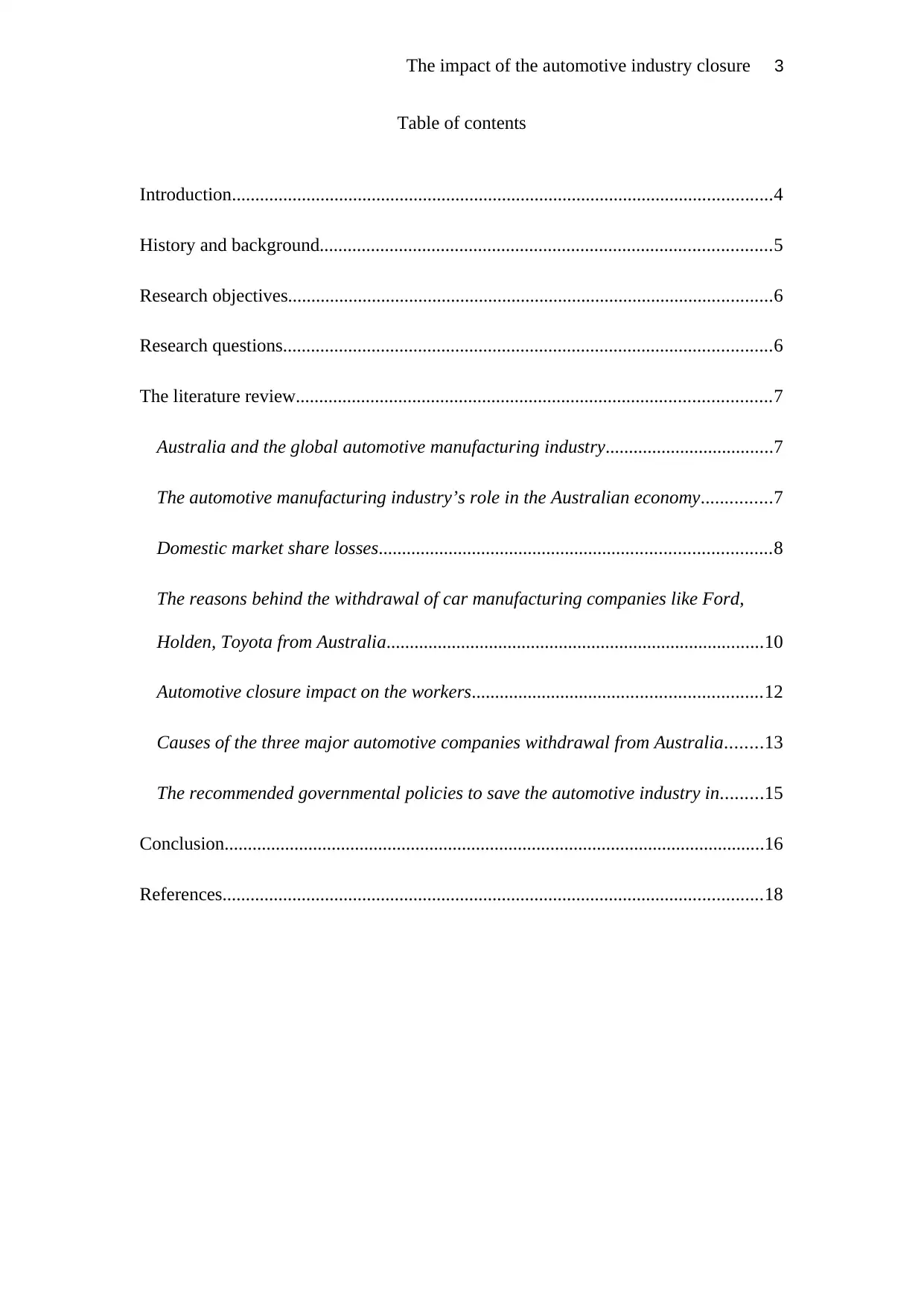
3The impact of the automotive industry closure
Table of contents
Introduction....................................................................................................................4
History and background.................................................................................................5
Research objectives........................................................................................................6
Research questions.........................................................................................................6
The literature review......................................................................................................7
Australia and the global automotive manufacturing industry....................................7
The automotive manufacturing industry’s role in the Australian economy...............7
Domestic market share losses....................................................................................8
The reasons behind the withdrawal of car manufacturing companies like Ford,
Holden, Toyota from Australia.................................................................................10
Automotive closure impact on the workers..............................................................12
Causes of the three major automotive companies withdrawal from Australia........13
The recommended governmental policies to save the automotive industry in.........15
Conclusion....................................................................................................................16
References....................................................................................................................18
Table of contents
Introduction....................................................................................................................4
History and background.................................................................................................5
Research objectives........................................................................................................6
Research questions.........................................................................................................6
The literature review......................................................................................................7
Australia and the global automotive manufacturing industry....................................7
The automotive manufacturing industry’s role in the Australian economy...............7
Domestic market share losses....................................................................................8
The reasons behind the withdrawal of car manufacturing companies like Ford,
Holden, Toyota from Australia.................................................................................10
Automotive closure impact on the workers..............................................................12
Causes of the three major automotive companies withdrawal from Australia........13
The recommended governmental policies to save the automotive industry in.........15
Conclusion....................................................................................................................16
References....................................................................................................................18
⊘ This is a preview!⊘
Do you want full access?
Subscribe today to unlock all pages.

Trusted by 1+ million students worldwide
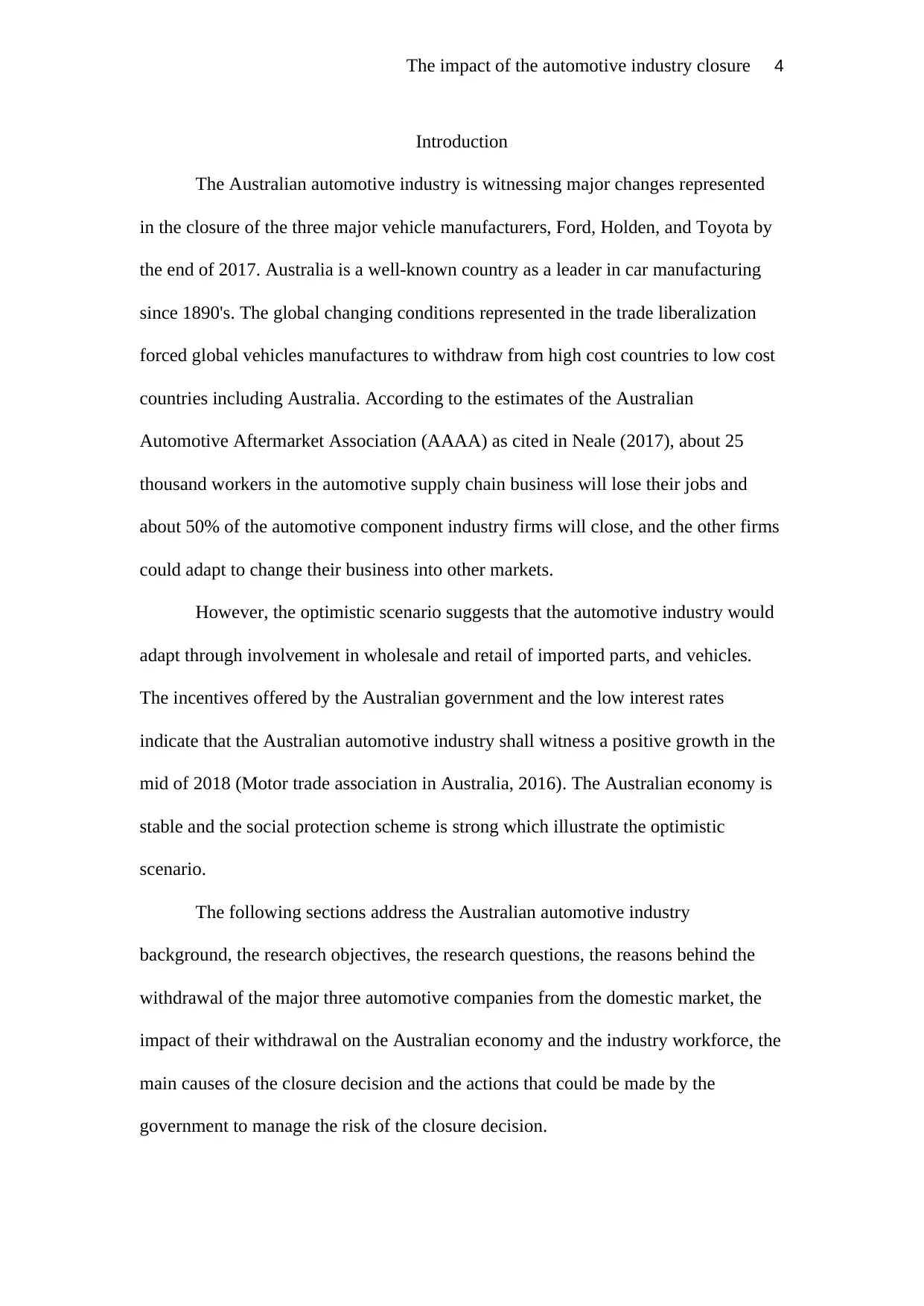
4The impact of the automotive industry closure
Introduction
The Australian automotive industry is witnessing major changes represented
in the closure of the three major vehicle manufacturers, Ford, Holden, and Toyota by
the end of 2017. Australia is a well-known country as a leader in car manufacturing
since 1890's. The global changing conditions represented in the trade liberalization
forced global vehicles manufactures to withdraw from high cost countries to low cost
countries including Australia. According to the estimates of the Australian
Automotive Aftermarket Association (AAAA) as cited in Neale (2017), about 25
thousand workers in the automotive supply chain business will lose their jobs and
about 50% of the automotive component industry firms will close, and the other firms
could adapt to change their business into other markets.
However, the optimistic scenario suggests that the automotive industry would
adapt through involvement in wholesale and retail of imported parts, and vehicles.
The incentives offered by the Australian government and the low interest rates
indicate that the Australian automotive industry shall witness a positive growth in the
mid of 2018 (Motor trade association in Australia, 2016). The Australian economy is
stable and the social protection scheme is strong which illustrate the optimistic
scenario.
The following sections address the Australian automotive industry
background, the research objectives, the research questions, the reasons behind the
withdrawal of the major three automotive companies from the domestic market, the
impact of their withdrawal on the Australian economy and the industry workforce, the
main causes of the closure decision and the actions that could be made by the
government to manage the risk of the closure decision.
Introduction
The Australian automotive industry is witnessing major changes represented
in the closure of the three major vehicle manufacturers, Ford, Holden, and Toyota by
the end of 2017. Australia is a well-known country as a leader in car manufacturing
since 1890's. The global changing conditions represented in the trade liberalization
forced global vehicles manufactures to withdraw from high cost countries to low cost
countries including Australia. According to the estimates of the Australian
Automotive Aftermarket Association (AAAA) as cited in Neale (2017), about 25
thousand workers in the automotive supply chain business will lose their jobs and
about 50% of the automotive component industry firms will close, and the other firms
could adapt to change their business into other markets.
However, the optimistic scenario suggests that the automotive industry would
adapt through involvement in wholesale and retail of imported parts, and vehicles.
The incentives offered by the Australian government and the low interest rates
indicate that the Australian automotive industry shall witness a positive growth in the
mid of 2018 (Motor trade association in Australia, 2016). The Australian economy is
stable and the social protection scheme is strong which illustrate the optimistic
scenario.
The following sections address the Australian automotive industry
background, the research objectives, the research questions, the reasons behind the
withdrawal of the major three automotive companies from the domestic market, the
impact of their withdrawal on the Australian economy and the industry workforce, the
main causes of the closure decision and the actions that could be made by the
government to manage the risk of the closure decision.
Paraphrase This Document
Need a fresh take? Get an instant paraphrase of this document with our AI Paraphraser
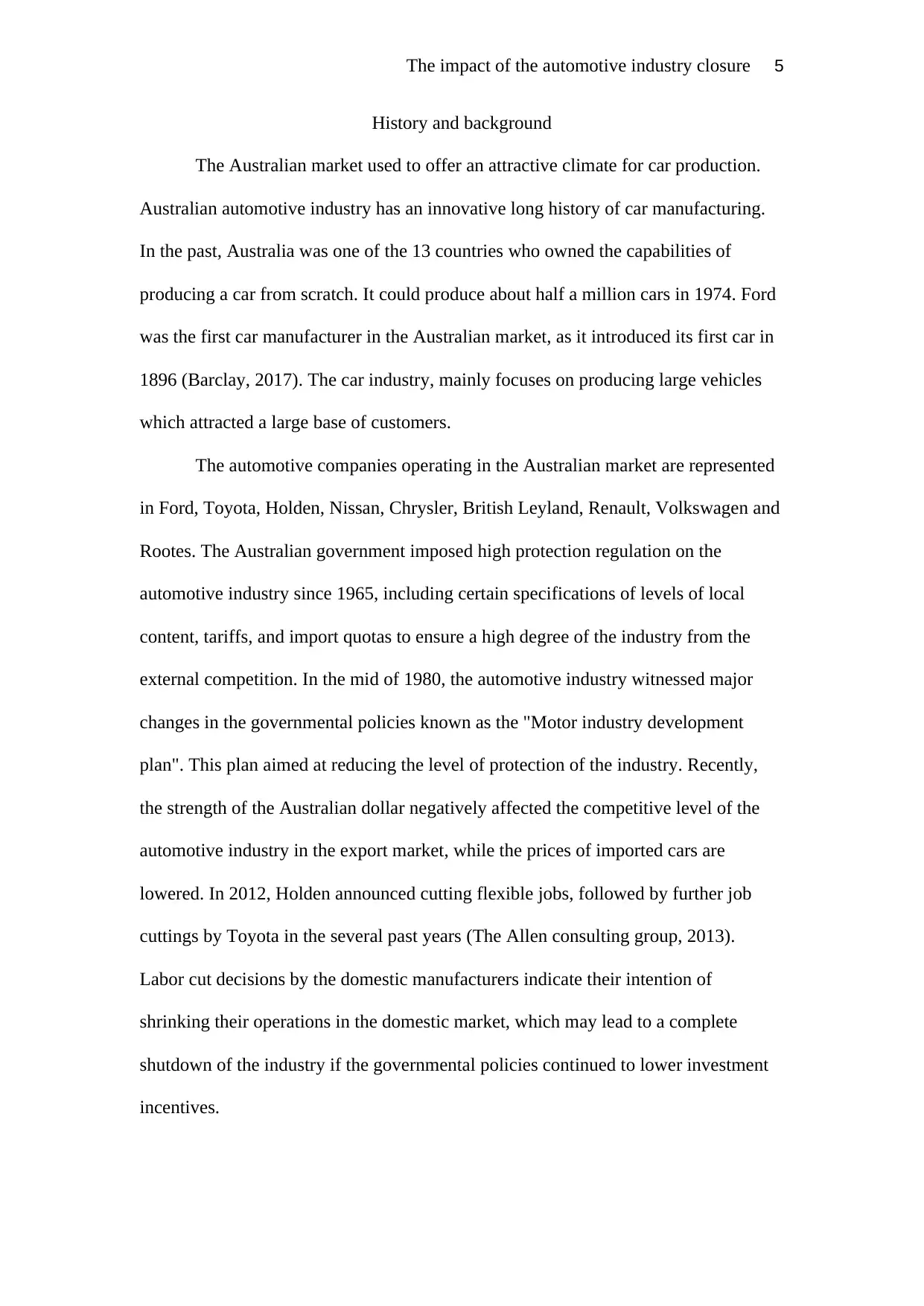
5The impact of the automotive industry closure
History and background
The Australian market used to offer an attractive climate for car production.
Australian automotive industry has an innovative long history of car manufacturing.
In the past, Australia was one of the 13 countries who owned the capabilities of
producing a car from scratch. It could produce about half a million cars in 1974. Ford
was the first car manufacturer in the Australian market, as it introduced its first car in
1896 (Barclay, 2017). The car industry, mainly focuses on producing large vehicles
which attracted a large base of customers.
The automotive companies operating in the Australian market are represented
in Ford, Toyota, Holden, Nissan, Chrysler, British Leyland, Renault, Volkswagen and
Rootes. The Australian government imposed high protection regulation on the
automotive industry since 1965, including certain specifications of levels of local
content, tariffs, and import quotas to ensure a high degree of the industry from the
external competition. In the mid of 1980, the automotive industry witnessed major
changes in the governmental policies known as the "Motor industry development
plan". This plan aimed at reducing the level of protection of the industry. Recently,
the strength of the Australian dollar negatively affected the competitive level of the
automotive industry in the export market, while the prices of imported cars are
lowered. In 2012, Holden announced cutting flexible jobs, followed by further job
cuttings by Toyota in the several past years (The Allen consulting group, 2013).
Labor cut decisions by the domestic manufacturers indicate their intention of
shrinking their operations in the domestic market, which may lead to a complete
shutdown of the industry if the governmental policies continued to lower investment
incentives.
History and background
The Australian market used to offer an attractive climate for car production.
Australian automotive industry has an innovative long history of car manufacturing.
In the past, Australia was one of the 13 countries who owned the capabilities of
producing a car from scratch. It could produce about half a million cars in 1974. Ford
was the first car manufacturer in the Australian market, as it introduced its first car in
1896 (Barclay, 2017). The car industry, mainly focuses on producing large vehicles
which attracted a large base of customers.
The automotive companies operating in the Australian market are represented
in Ford, Toyota, Holden, Nissan, Chrysler, British Leyland, Renault, Volkswagen and
Rootes. The Australian government imposed high protection regulation on the
automotive industry since 1965, including certain specifications of levels of local
content, tariffs, and import quotas to ensure a high degree of the industry from the
external competition. In the mid of 1980, the automotive industry witnessed major
changes in the governmental policies known as the "Motor industry development
plan". This plan aimed at reducing the level of protection of the industry. Recently,
the strength of the Australian dollar negatively affected the competitive level of the
automotive industry in the export market, while the prices of imported cars are
lowered. In 2012, Holden announced cutting flexible jobs, followed by further job
cuttings by Toyota in the several past years (The Allen consulting group, 2013).
Labor cut decisions by the domestic manufacturers indicate their intention of
shrinking their operations in the domestic market, which may lead to a complete
shutdown of the industry if the governmental policies continued to lower investment
incentives.
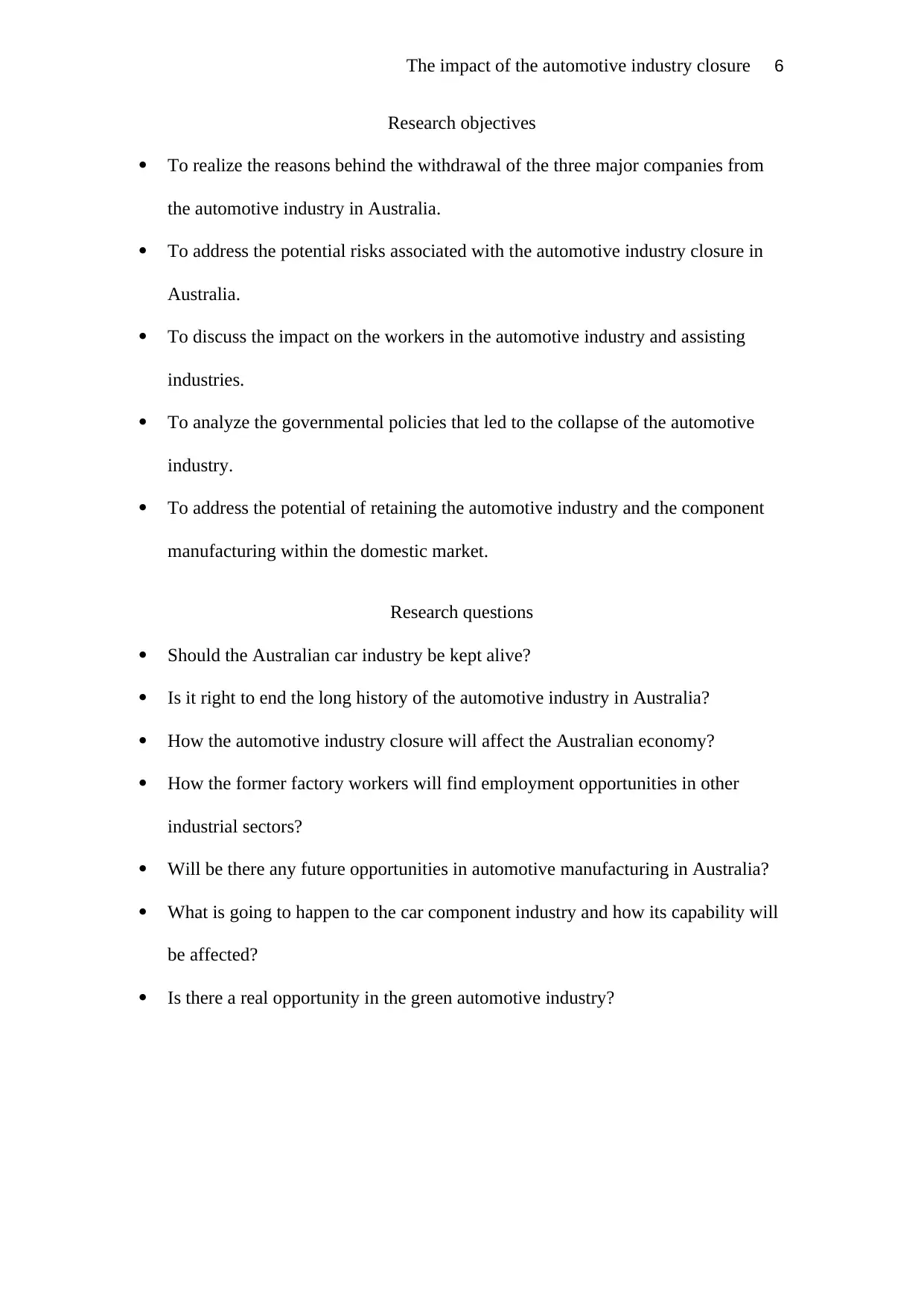
6The impact of the automotive industry closure
Research objectives
To realize the reasons behind the withdrawal of the three major companies from
the automotive industry in Australia.
To address the potential risks associated with the automotive industry closure in
Australia.
To discuss the impact on the workers in the automotive industry and assisting
industries.
To analyze the governmental policies that led to the collapse of the automotive
industry.
To address the potential of retaining the automotive industry and the component
manufacturing within the domestic market.
Research questions
Should the Australian car industry be kept alive?
Is it right to end the long history of the automotive industry in Australia?
How the automotive industry closure will affect the Australian economy?
How the former factory workers will find employment opportunities in other
industrial sectors?
Will be there any future opportunities in automotive manufacturing in Australia?
What is going to happen to the car component industry and how its capability will
be affected?
Is there a real opportunity in the green automotive industry?
Research objectives
To realize the reasons behind the withdrawal of the three major companies from
the automotive industry in Australia.
To address the potential risks associated with the automotive industry closure in
Australia.
To discuss the impact on the workers in the automotive industry and assisting
industries.
To analyze the governmental policies that led to the collapse of the automotive
industry.
To address the potential of retaining the automotive industry and the component
manufacturing within the domestic market.
Research questions
Should the Australian car industry be kept alive?
Is it right to end the long history of the automotive industry in Australia?
How the automotive industry closure will affect the Australian economy?
How the former factory workers will find employment opportunities in other
industrial sectors?
Will be there any future opportunities in automotive manufacturing in Australia?
What is going to happen to the car component industry and how its capability will
be affected?
Is there a real opportunity in the green automotive industry?
⊘ This is a preview!⊘
Do you want full access?
Subscribe today to unlock all pages.

Trusted by 1+ million students worldwide
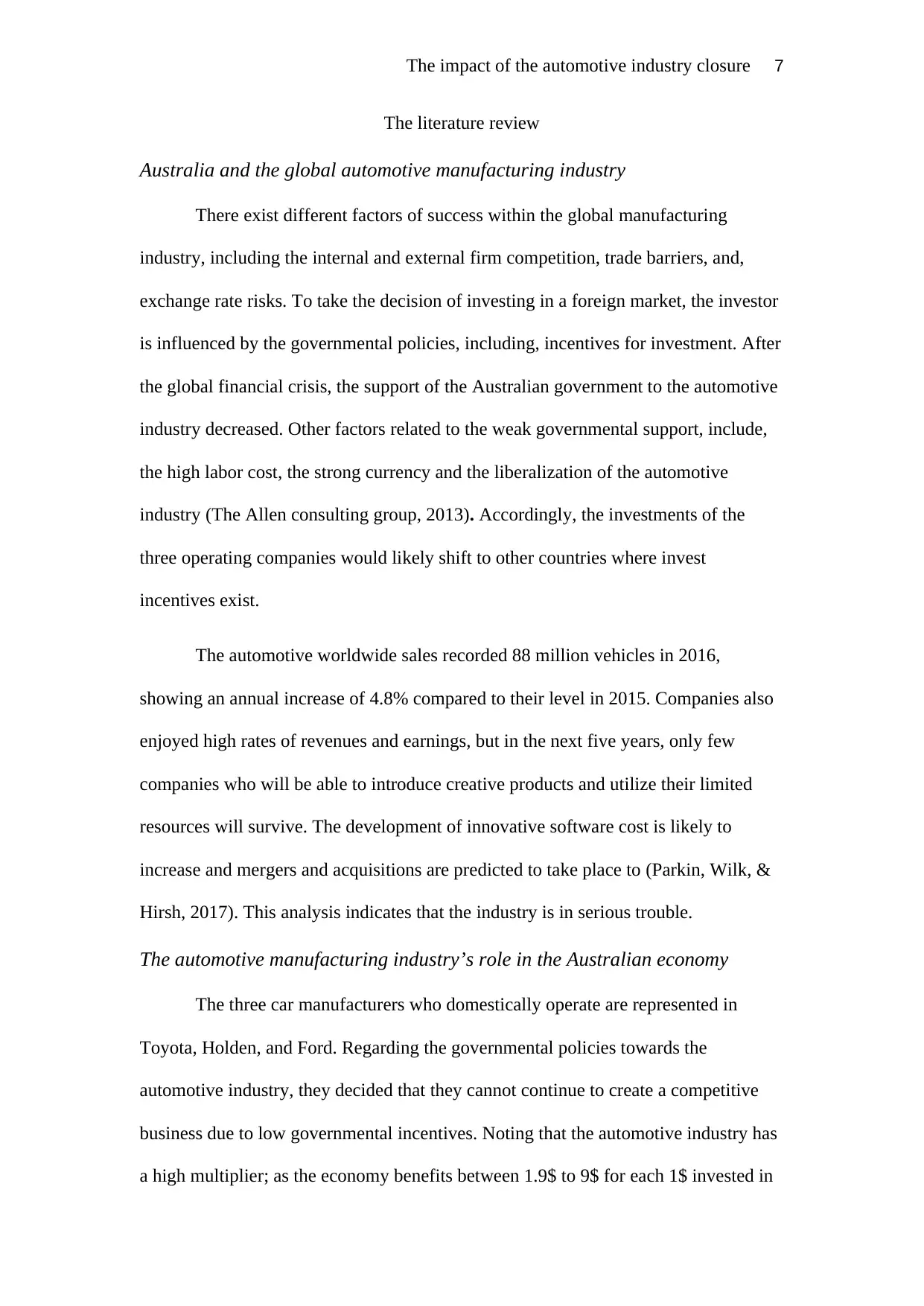
7The impact of the automotive industry closure
The literature review
Australia and the global automotive manufacturing industry
There exist different factors of success within the global manufacturing
industry, including the internal and external firm competition, trade barriers, and,
exchange rate risks. To take the decision of investing in a foreign market, the investor
is influenced by the governmental policies, including, incentives for investment. After
the global financial crisis, the support of the Australian government to the automotive
industry decreased. Other factors related to the weak governmental support, include,
the high labor cost, the strong currency and the liberalization of the automotive
industry (The Allen consulting group, 2013). Accordingly, the investments of the
three operating companies would likely shift to other countries where invest
incentives exist.
The automotive worldwide sales recorded 88 million vehicles in 2016,
showing an annual increase of 4.8% compared to their level in 2015. Companies also
enjoyed high rates of revenues and earnings, but in the next five years, only few
companies who will be able to introduce creative products and utilize their limited
resources will survive. The development of innovative software cost is likely to
increase and mergers and acquisitions are predicted to take place to (Parkin, Wilk, &
Hirsh, 2017). This analysis indicates that the industry is in serious trouble.
The automotive manufacturing industry’s role in the Australian economy
The three car manufacturers who domestically operate are represented in
Toyota, Holden, and Ford. Regarding the governmental policies towards the
automotive industry, they decided that they cannot continue to create a competitive
business due to low governmental incentives. Noting that the automotive industry has
a high multiplier; as the economy benefits between 1.9$ to 9$ for each 1$ invested in
The literature review
Australia and the global automotive manufacturing industry
There exist different factors of success within the global manufacturing
industry, including the internal and external firm competition, trade barriers, and,
exchange rate risks. To take the decision of investing in a foreign market, the investor
is influenced by the governmental policies, including, incentives for investment. After
the global financial crisis, the support of the Australian government to the automotive
industry decreased. Other factors related to the weak governmental support, include,
the high labor cost, the strong currency and the liberalization of the automotive
industry (The Allen consulting group, 2013). Accordingly, the investments of the
three operating companies would likely shift to other countries where invest
incentives exist.
The automotive worldwide sales recorded 88 million vehicles in 2016,
showing an annual increase of 4.8% compared to their level in 2015. Companies also
enjoyed high rates of revenues and earnings, but in the next five years, only few
companies who will be able to introduce creative products and utilize their limited
resources will survive. The development of innovative software cost is likely to
increase and mergers and acquisitions are predicted to take place to (Parkin, Wilk, &
Hirsh, 2017). This analysis indicates that the industry is in serious trouble.
The automotive manufacturing industry’s role in the Australian economy
The three car manufacturers who domestically operate are represented in
Toyota, Holden, and Ford. Regarding the governmental policies towards the
automotive industry, they decided that they cannot continue to create a competitive
business due to low governmental incentives. Noting that the automotive industry has
a high multiplier; as the economy benefits between 1.9$ to 9$ for each 1$ invested in
Paraphrase This Document
Need a fresh take? Get an instant paraphrase of this document with our AI Paraphraser
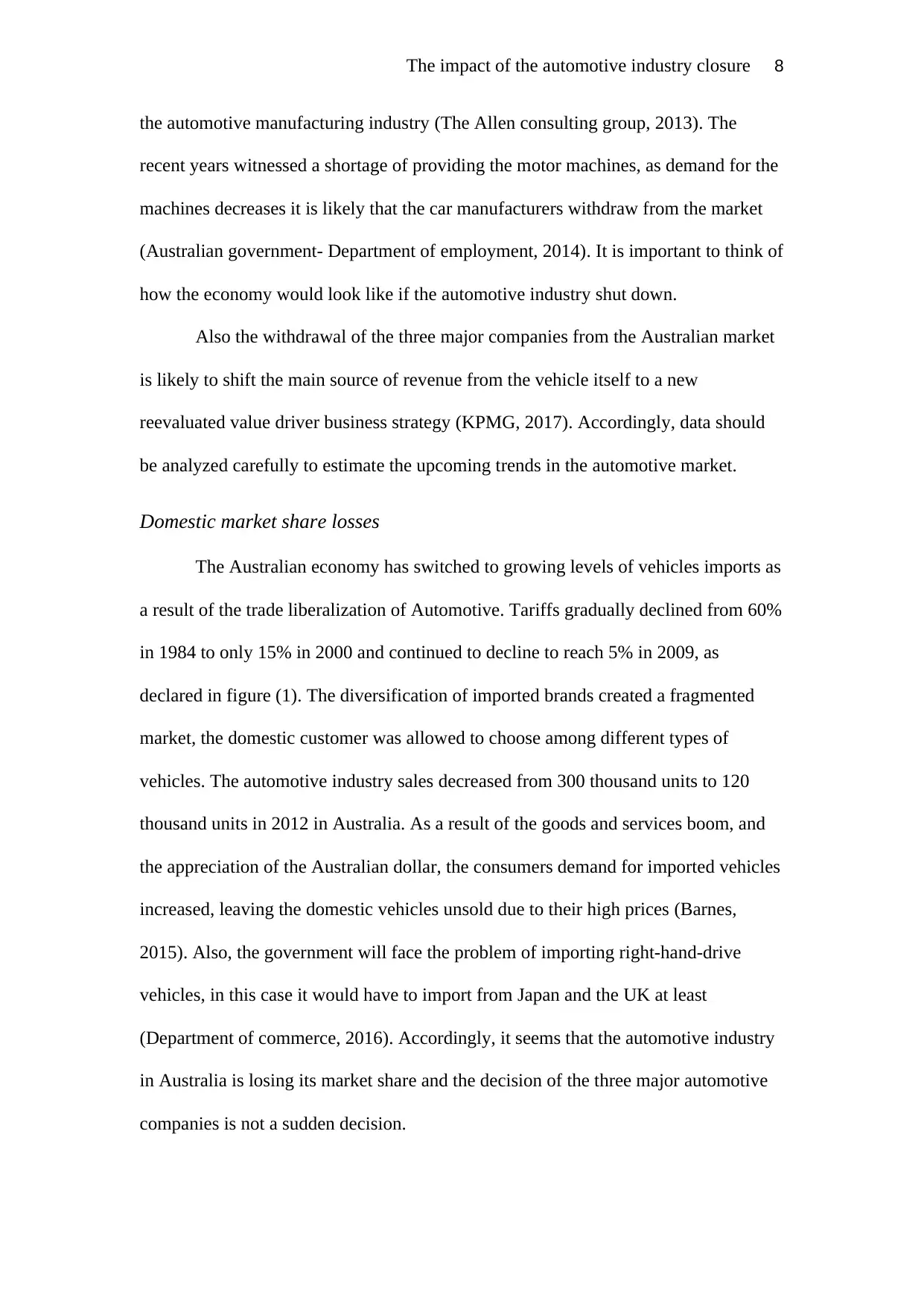
8The impact of the automotive industry closure
the automotive manufacturing industry (The Allen consulting group, 2013). The
recent years witnessed a shortage of providing the motor machines, as demand for the
machines decreases it is likely that the car manufacturers withdraw from the market
(Australian government- Department of employment, 2014). It is important to think of
how the economy would look like if the automotive industry shut down.
Also the withdrawal of the three major companies from the Australian market
is likely to shift the main source of revenue from the vehicle itself to a new
reevaluated value driver business strategy (KPMG, 2017). Accordingly, data should
be analyzed carefully to estimate the upcoming trends in the automotive market.
Domestic market share losses
The Australian economy has switched to growing levels of vehicles imports as
a result of the trade liberalization of Automotive. Tariffs gradually declined from 60%
in 1984 to only 15% in 2000 and continued to decline to reach 5% in 2009, as
declared in figure (1). The diversification of imported brands created a fragmented
market, the domestic customer was allowed to choose among different types of
vehicles. The automotive industry sales decreased from 300 thousand units to 120
thousand units in 2012 in Australia. As a result of the goods and services boom, and
the appreciation of the Australian dollar, the consumers demand for imported vehicles
increased, leaving the domestic vehicles unsold due to their high prices (Barnes,
2015). Also, the government will face the problem of importing right-hand-drive
vehicles, in this case it would have to import from Japan and the UK at least
(Department of commerce, 2016). Accordingly, it seems that the automotive industry
in Australia is losing its market share and the decision of the three major automotive
companies is not a sudden decision.
the automotive manufacturing industry (The Allen consulting group, 2013). The
recent years witnessed a shortage of providing the motor machines, as demand for the
machines decreases it is likely that the car manufacturers withdraw from the market
(Australian government- Department of employment, 2014). It is important to think of
how the economy would look like if the automotive industry shut down.
Also the withdrawal of the three major companies from the Australian market
is likely to shift the main source of revenue from the vehicle itself to a new
reevaluated value driver business strategy (KPMG, 2017). Accordingly, data should
be analyzed carefully to estimate the upcoming trends in the automotive market.
Domestic market share losses
The Australian economy has switched to growing levels of vehicles imports as
a result of the trade liberalization of Automotive. Tariffs gradually declined from 60%
in 1984 to only 15% in 2000 and continued to decline to reach 5% in 2009, as
declared in figure (1). The diversification of imported brands created a fragmented
market, the domestic customer was allowed to choose among different types of
vehicles. The automotive industry sales decreased from 300 thousand units to 120
thousand units in 2012 in Australia. As a result of the goods and services boom, and
the appreciation of the Australian dollar, the consumers demand for imported vehicles
increased, leaving the domestic vehicles unsold due to their high prices (Barnes,
2015). Also, the government will face the problem of importing right-hand-drive
vehicles, in this case it would have to import from Japan and the UK at least
(Department of commerce, 2016). Accordingly, it seems that the automotive industry
in Australia is losing its market share and the decision of the three major automotive
companies is not a sudden decision.
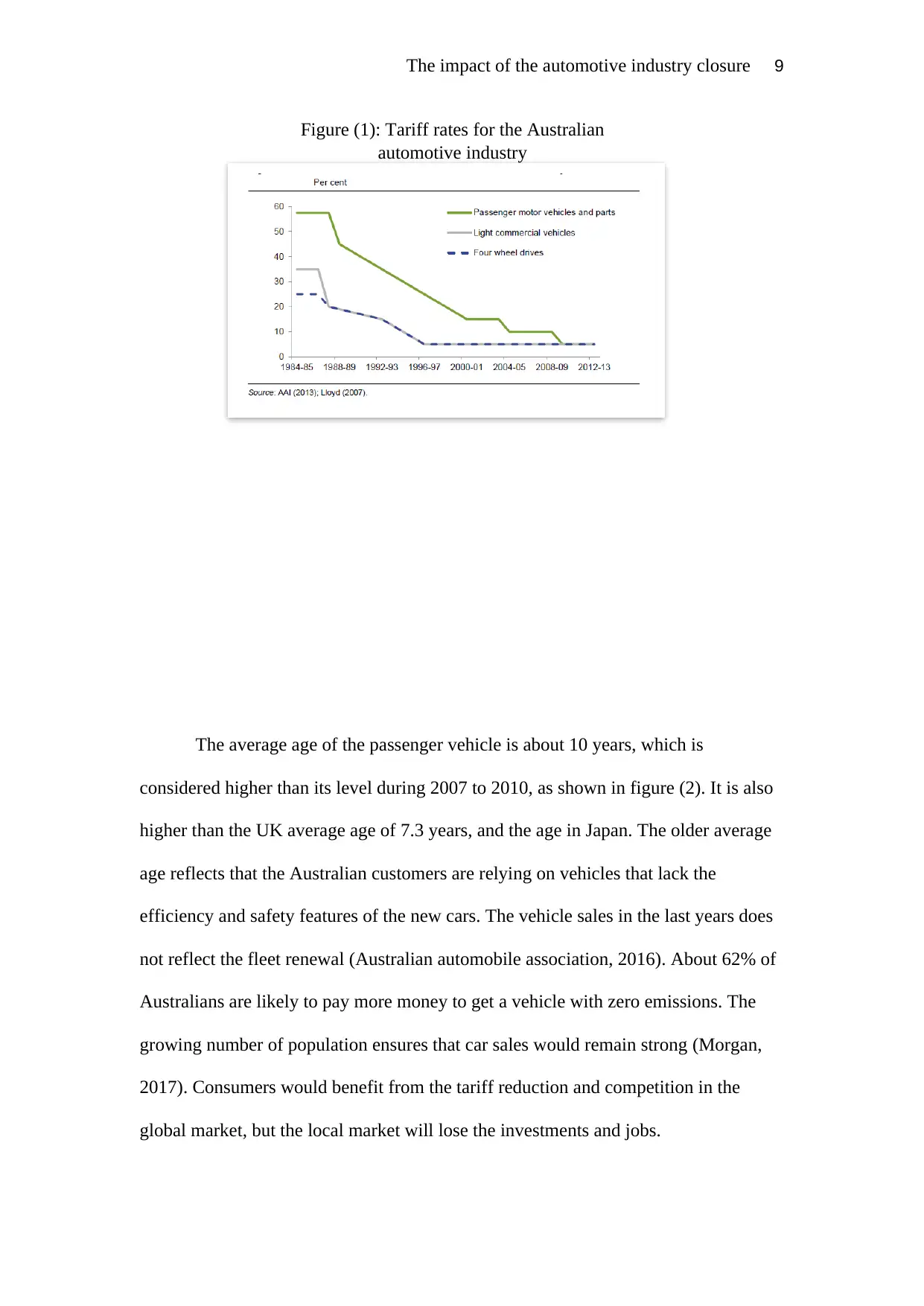
9The impact of the automotive industry closure
The average age of the passenger vehicle is about 10 years, which is
considered higher than its level during 2007 to 2010, as shown in figure (2). It is also
higher than the UK average age of 7.3 years, and the age in Japan. The older average
age reflects that the Australian customers are relying on vehicles that lack the
efficiency and safety features of the new cars. The vehicle sales in the last years does
not reflect the fleet renewal (Australian automobile association, 2016). About 62% of
Australians are likely to pay more money to get a vehicle with zero emissions. The
growing number of population ensures that car sales would remain strong (Morgan,
2017). Consumers would benefit from the tariff reduction and competition in the
global market, but the local market will lose the investments and jobs.
Figure (1): Tariff rates for the Australian
automotive industry
The average age of the passenger vehicle is about 10 years, which is
considered higher than its level during 2007 to 2010, as shown in figure (2). It is also
higher than the UK average age of 7.3 years, and the age in Japan. The older average
age reflects that the Australian customers are relying on vehicles that lack the
efficiency and safety features of the new cars. The vehicle sales in the last years does
not reflect the fleet renewal (Australian automobile association, 2016). About 62% of
Australians are likely to pay more money to get a vehicle with zero emissions. The
growing number of population ensures that car sales would remain strong (Morgan,
2017). Consumers would benefit from the tariff reduction and competition in the
global market, but the local market will lose the investments and jobs.
Figure (1): Tariff rates for the Australian
automotive industry
⊘ This is a preview!⊘
Do you want full access?
Subscribe today to unlock all pages.

Trusted by 1+ million students worldwide
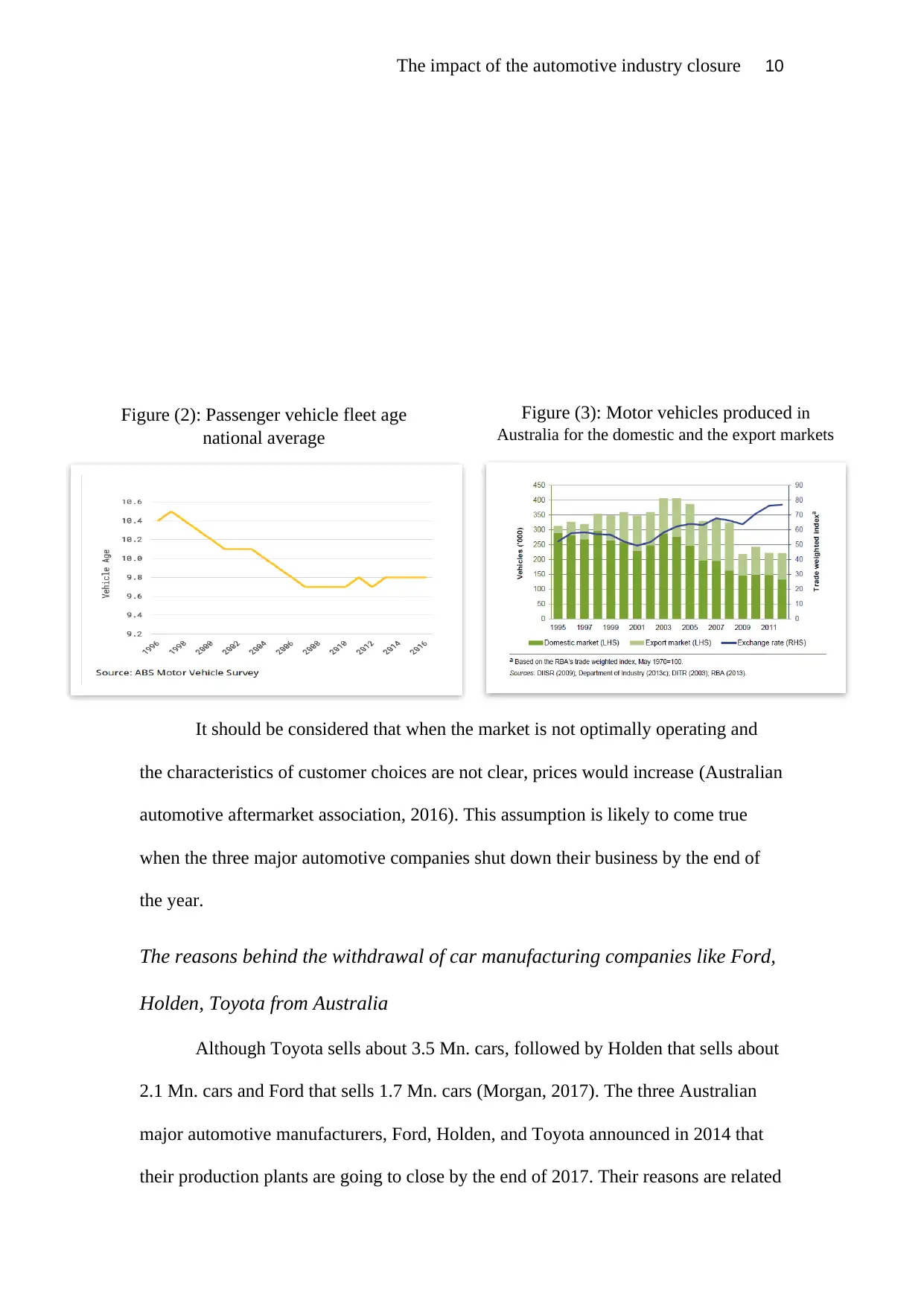
10The impact of the automotive industry closure
It should be considered that when the market is not optimally operating and
the characteristics of customer choices are not clear, prices would increase (Australian
automotive aftermarket association, 2016). This assumption is likely to come true
when the three major automotive companies shut down their business by the end of
the year.
The reasons behind the withdrawal of car manufacturing companies like Ford,
Holden, Toyota from Australia
Although Toyota sells about 3.5 Mn. cars, followed by Holden that sells about
2.1 Mn. cars and Ford that sells 1.7 Mn. cars (Morgan, 2017). The three Australian
major automotive manufacturers, Ford, Holden, and Toyota announced in 2014 that
their production plants are going to close by the end of 2017. Their reasons are related
Figure (2): Passenger vehicle fleet age
national average
Figure (3): Motor vehicles produced in
Australia for the domestic and the export markets
It should be considered that when the market is not optimally operating and
the characteristics of customer choices are not clear, prices would increase (Australian
automotive aftermarket association, 2016). This assumption is likely to come true
when the three major automotive companies shut down their business by the end of
the year.
The reasons behind the withdrawal of car manufacturing companies like Ford,
Holden, Toyota from Australia
Although Toyota sells about 3.5 Mn. cars, followed by Holden that sells about
2.1 Mn. cars and Ford that sells 1.7 Mn. cars (Morgan, 2017). The three Australian
major automotive manufacturers, Ford, Holden, and Toyota announced in 2014 that
their production plants are going to close by the end of 2017. Their reasons are related
Figure (2): Passenger vehicle fleet age
national average
Figure (3): Motor vehicles produced in
Australia for the domestic and the export markets
Paraphrase This Document
Need a fresh take? Get an instant paraphrase of this document with our AI Paraphraser
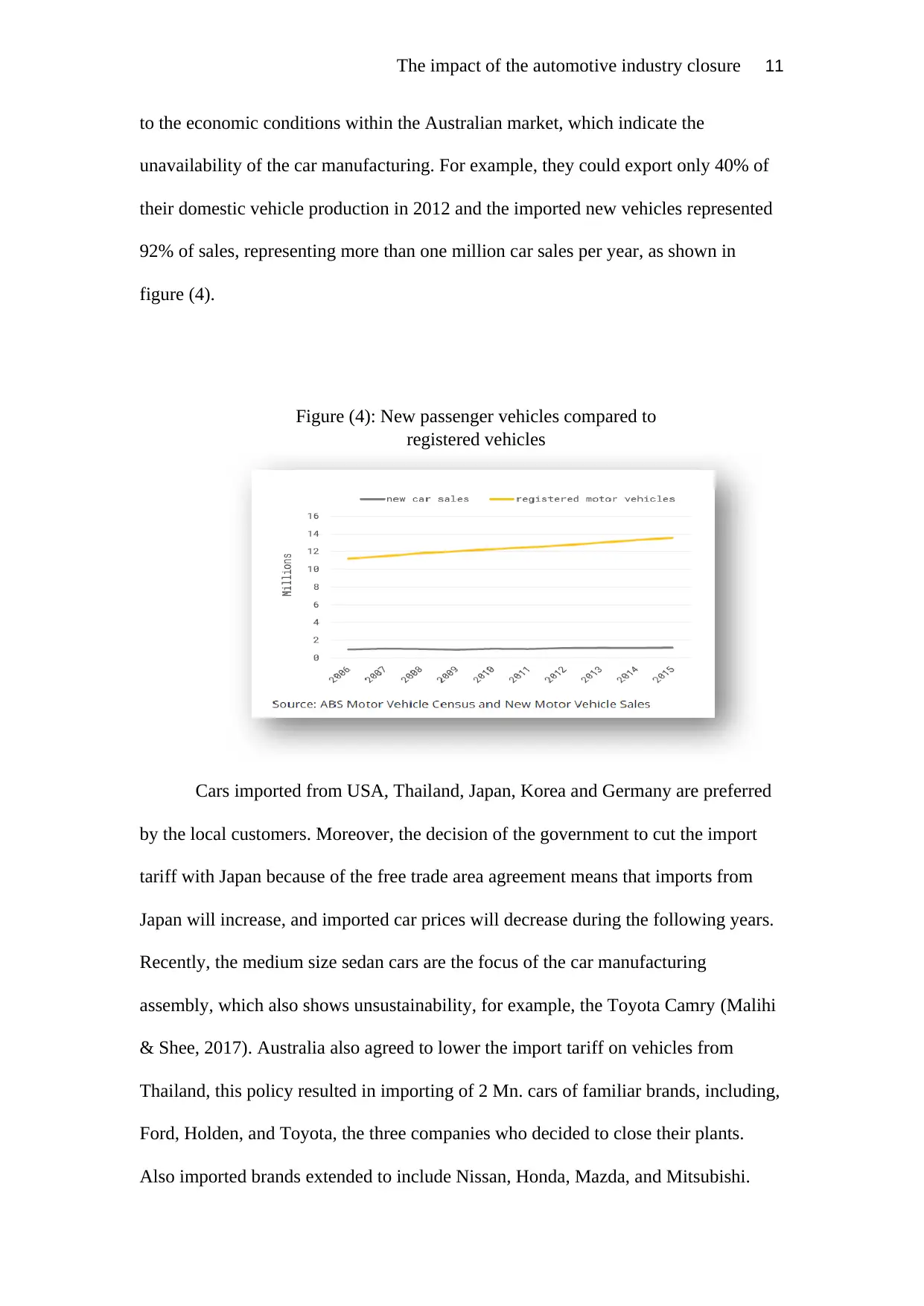
11The impact of the automotive industry closure
to the economic conditions within the Australian market, which indicate the
unavailability of the car manufacturing. For example, they could export only 40% of
their domestic vehicle production in 2012 and the imported new vehicles represented
92% of sales, representing more than one million car sales per year, as shown in
figure (4).
Cars imported from USA, Thailand, Japan, Korea and Germany are preferred
by the local customers. Moreover, the decision of the government to cut the import
tariff with Japan because of the free trade area agreement means that imports from
Japan will increase, and imported car prices will decrease during the following years.
Recently, the medium size sedan cars are the focus of the car manufacturing
assembly, which also shows unsustainability, for example, the Toyota Camry (Malihi
& Shee, 2017). Australia also agreed to lower the import tariff on vehicles from
Thailand, this policy resulted in importing of 2 Mn. cars of familiar brands, including,
Ford, Holden, and Toyota, the three companies who decided to close their plants.
Also imported brands extended to include Nissan, Honda, Mazda, and Mitsubishi.
Figure (4): New passenger vehicles compared to
registered vehicles
to the economic conditions within the Australian market, which indicate the
unavailability of the car manufacturing. For example, they could export only 40% of
their domestic vehicle production in 2012 and the imported new vehicles represented
92% of sales, representing more than one million car sales per year, as shown in
figure (4).
Cars imported from USA, Thailand, Japan, Korea and Germany are preferred
by the local customers. Moreover, the decision of the government to cut the import
tariff with Japan because of the free trade area agreement means that imports from
Japan will increase, and imported car prices will decrease during the following years.
Recently, the medium size sedan cars are the focus of the car manufacturing
assembly, which also shows unsustainability, for example, the Toyota Camry (Malihi
& Shee, 2017). Australia also agreed to lower the import tariff on vehicles from
Thailand, this policy resulted in importing of 2 Mn. cars of familiar brands, including,
Ford, Holden, and Toyota, the three companies who decided to close their plants.
Also imported brands extended to include Nissan, Honda, Mazda, and Mitsubishi.
Figure (4): New passenger vehicles compared to
registered vehicles
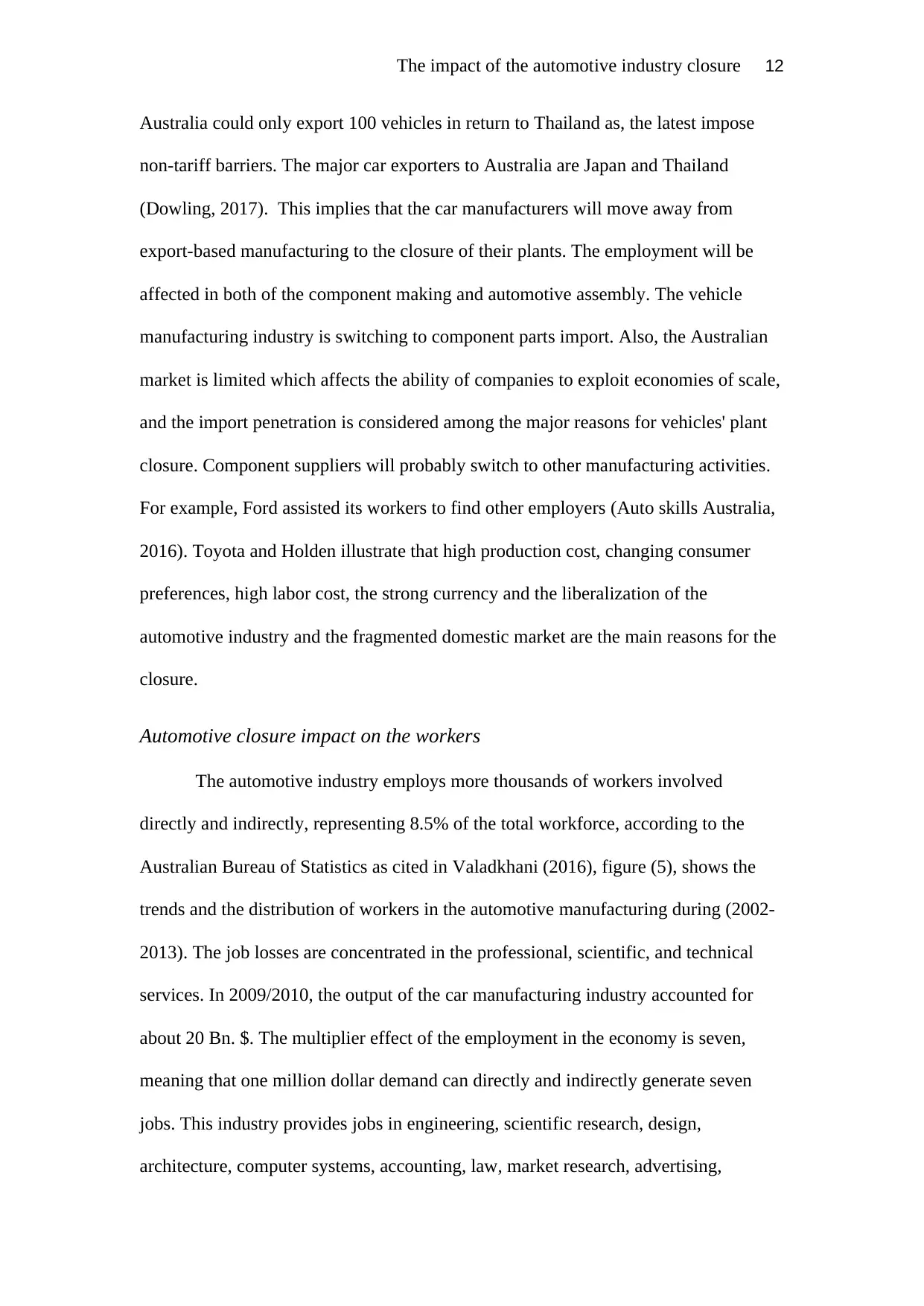
12The impact of the automotive industry closure
Australia could only export 100 vehicles in return to Thailand as, the latest impose
non-tariff barriers. The major car exporters to Australia are Japan and Thailand
(Dowling, 2017). This implies that the car manufacturers will move away from
export-based manufacturing to the closure of their plants. The employment will be
affected in both of the component making and automotive assembly. The vehicle
manufacturing industry is switching to component parts import. Also, the Australian
market is limited which affects the ability of companies to exploit economies of scale,
and the import penetration is considered among the major reasons for vehicles' plant
closure. Component suppliers will probably switch to other manufacturing activities.
For example, Ford assisted its workers to find other employers (Auto skills Australia,
2016). Toyota and Holden illustrate that high production cost, changing consumer
preferences, high labor cost, the strong currency and the liberalization of the
automotive industry and the fragmented domestic market are the main reasons for the
closure.
Automotive closure impact on the workers
The automotive industry employs more thousands of workers involved
directly and indirectly, representing 8.5% of the total workforce, according to the
Australian Bureau of Statistics as cited in Valadkhani (2016), figure (5), shows the
trends and the distribution of workers in the automotive manufacturing during (2002-
2013). The job losses are concentrated in the professional, scientific, and technical
services. In 2009/2010, the output of the car manufacturing industry accounted for
about 20 Bn. $. The multiplier effect of the employment in the economy is seven,
meaning that one million dollar demand can directly and indirectly generate seven
jobs. This industry provides jobs in engineering, scientific research, design,
architecture, computer systems, accounting, law, market research, advertising,
Australia could only export 100 vehicles in return to Thailand as, the latest impose
non-tariff barriers. The major car exporters to Australia are Japan and Thailand
(Dowling, 2017). This implies that the car manufacturers will move away from
export-based manufacturing to the closure of their plants. The employment will be
affected in both of the component making and automotive assembly. The vehicle
manufacturing industry is switching to component parts import. Also, the Australian
market is limited which affects the ability of companies to exploit economies of scale,
and the import penetration is considered among the major reasons for vehicles' plant
closure. Component suppliers will probably switch to other manufacturing activities.
For example, Ford assisted its workers to find other employers (Auto skills Australia,
2016). Toyota and Holden illustrate that high production cost, changing consumer
preferences, high labor cost, the strong currency and the liberalization of the
automotive industry and the fragmented domestic market are the main reasons for the
closure.
Automotive closure impact on the workers
The automotive industry employs more thousands of workers involved
directly and indirectly, representing 8.5% of the total workforce, according to the
Australian Bureau of Statistics as cited in Valadkhani (2016), figure (5), shows the
trends and the distribution of workers in the automotive manufacturing during (2002-
2013). The job losses are concentrated in the professional, scientific, and technical
services. In 2009/2010, the output of the car manufacturing industry accounted for
about 20 Bn. $. The multiplier effect of the employment in the economy is seven,
meaning that one million dollar demand can directly and indirectly generate seven
jobs. This industry provides jobs in engineering, scientific research, design,
architecture, computer systems, accounting, law, market research, advertising,
⊘ This is a preview!⊘
Do you want full access?
Subscribe today to unlock all pages.

Trusted by 1+ million students worldwide
1 out of 19
Related Documents
Your All-in-One AI-Powered Toolkit for Academic Success.
+13062052269
info@desklib.com
Available 24*7 on WhatsApp / Email
![[object Object]](/_next/static/media/star-bottom.7253800d.svg)
Unlock your academic potential
Copyright © 2020–2025 A2Z Services. All Rights Reserved. Developed and managed by ZUCOL.





